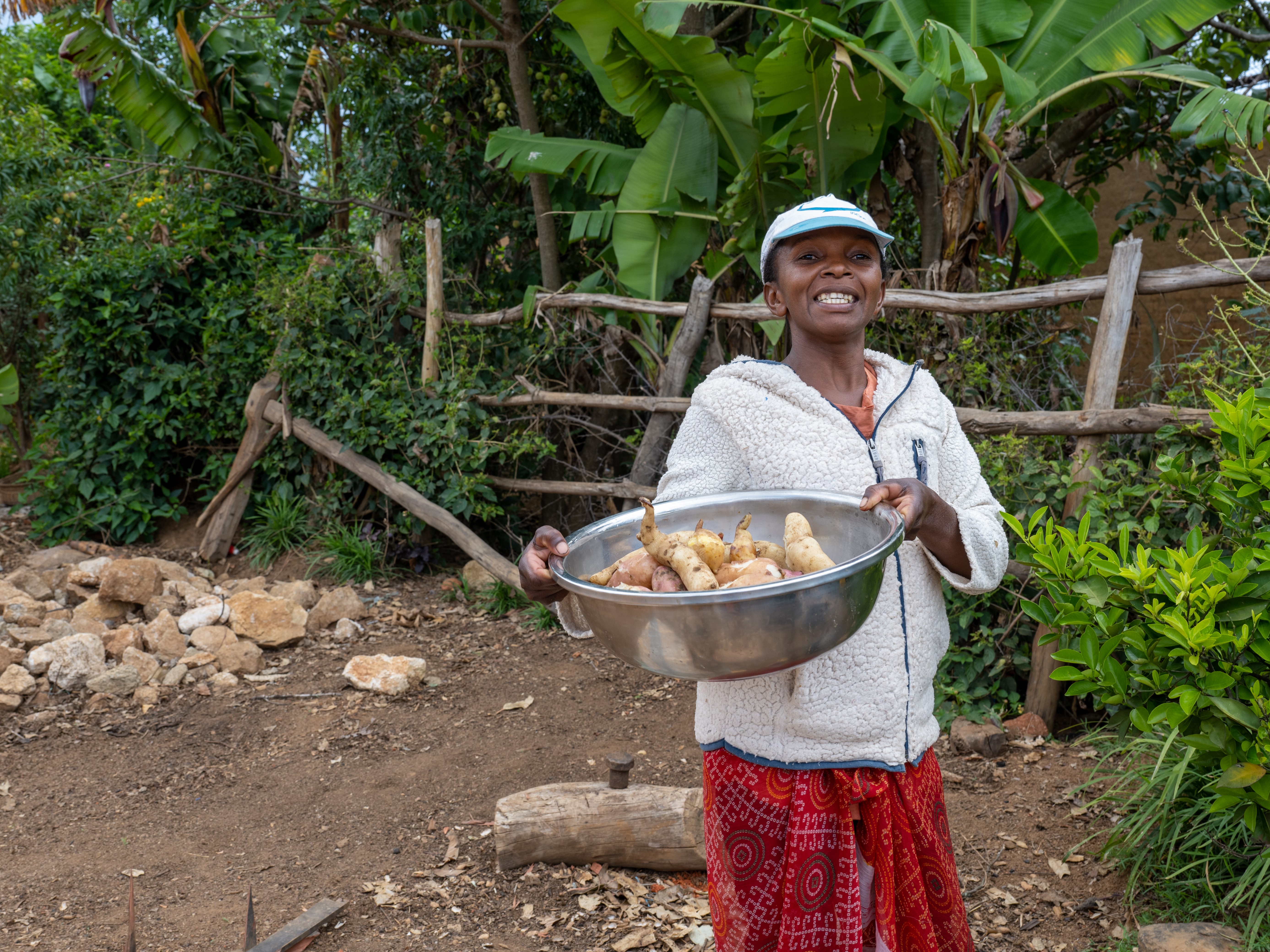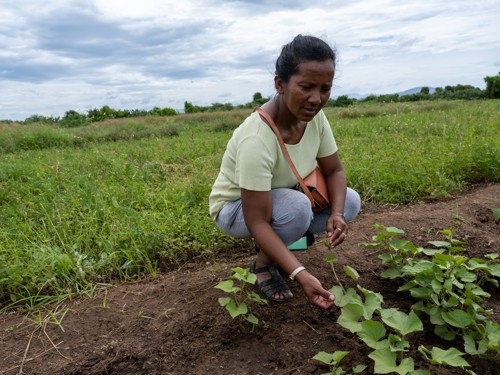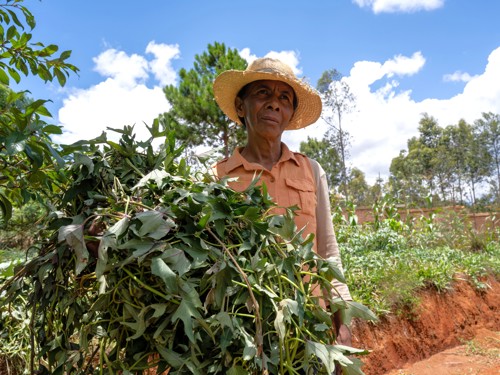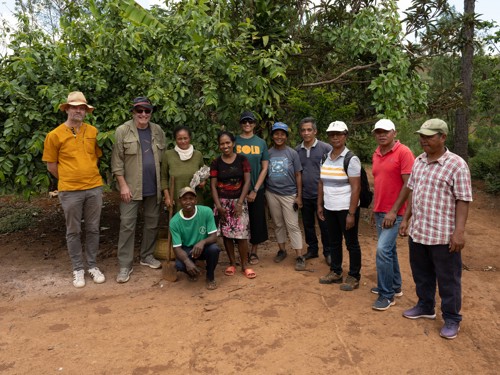Sweet success and improved food security

Nirina offers freshly boiled sweetpotato roots to her guests. Credit - Marta Millere / Crop Trust.
A fresh start for sweetpotato farmers
In a rural community near the city of Antsirabe, Madagascar, a farmer named Fulatina holds an aluminium pot of boiled sweetpotatoes. These starchy roots are of the same variety but from different plants – one healthy, one diseased. The root from the healthy plant is about eight times larger than that from the diseased.
Sweetpotato is a key source of nutrition in Madagascar. In the south, it is well suited to the dry climate and sandy soils. In the highlands, it is grown in small plots as a buffer against hunger during the lean season and in the east it’s widely cultivated throughout the year for home consumption. All over the country, sweetpotato chips are becoming very popular. But reduced yields caused by diseases can significantly affect lives and livelihoods.
However, Fulatina does not need to worry about this quite so much, thanks to the project ‘Sweetpotato, a model for food security and long-term conservation of biodiversity’. Funded by the UK Government’s Darwin Initiative, CGIAR, and the Crop Trust, it was implemented in Madagascar and Zambia, where the crop is equally important.


A project to protect the sweetpotato
The idea of the project is easily described – to conserve, clean and share.
In Madagascar, smallholder farmers grow a wide range of traditional sweetpotato landraces, each adapted to local climates, soils, and preferences. But this rich diversity is under threat – from disease, pests, climate change and evolving farming systems.
When the project launched in 2022, partners hit the ground running. They collected local traditional varieties that farmers told them were important to local communities. These plants were cleaned of diseases and processed for conservation, including in cryopreservation (storing plant material in liquid nitrogen at –196°C) in the genebank of the International Potato Center (CIP) in Peru. At the same time, disease-free planting material was returned to smallholder farmers in the two partner countries to grow in their fields. Conserving for future use in research and breeding, cleaning, and sharing for immediate use by farmers.
Because sweetpotato is propagated by cuttings rather than seeds, conserving its diversity is especially complex. Most collections are kept in the field or in vitro (as plantlets in test tubes), both of which are costly and vulnerable. That’s why cryopreservation is considered the most secure and sustainable long-term option.
This project enlarged the world’s collection of sweetpotato diversity with valuable landraces from Madagascar and Zambia that might otherwise have been lost. Before it began, the global sweetpotato in vitro and cryo gene bank at CIP held just six landraces from the two countries. By the end, more than 300 had been collected, cleaned, and conserved under the rules of access and benefit-sharing of the International Treaty on Plant Genetic Resources for Food and Agriculture. This ensures they remain available to farmers, breeders, and researchers everywhere, for generations to come.

Farmers Seeing Success
In 2025, Dr Noroseheno Ralisoa, a scientist at Fiompiana Fambolena Malagasy Norvéziana (FIFAMANOR), the project’s partner organisation in Madagascar, accompanied representatives from the Crop Trust and CIP to observe firsthand the project’s effects on food security.
They visited communities in three locations. In each place, they saw key farmers act as multipliers, distributors, and trend-setters, getting clean vines of local sweetpotato varieties into their neighbours’ fields.
Fulatina worked closely with these passionate champions of diversity. “In three to five years, she expects all the farmers to have clean vines,” Ralisoa says, translating for Fulatina, who speaks the local language, Malagasy. Using its clean planting materials, accompanied by training on keeping the plants disease-free, the project is making a significant impact on Fulatina’s livelihood, and that of many other farmers in Madagascar.
Over the course of the project, more than 40,000 vine cuttings reached 295 farmers across the country. Because of their enthusiasm for the clean vines, they in turn shared them with their friends and neighbours.
“With disease-free material, farmers could realise 30-50% yield gains in a single year,” says Dr David Ellis, Scientist Emeritus at CIP. “This method could be applied to other crops spread by cuttings, such as cassava, potato, yam and even banana.”
In addition to improved yields, farmers reported visible improvements in the quality of their harvests. They observed fewer disease and insect attacks than in previous seasons. Almost 75% of farmers indicated they now have a more consistent supply of sweetpotato throughout the year, reducing reliance on external food sources.
The project, which ended in March this year, has demonstrated that clean planting material, farmer-to-farmer sharing, and local leadership can strengthen resilience for farming communities. And the newly conserved diversity means others will benefit, too.
As for Fulatina, she is proud of her pale pink root harvest and offers her guests a taste. Delicious.
Related news: https://www.darwininitiative.org.uk/news/2024/09/16/sweetpotato-project-strengthens-communities/
Written by David Henry. For more information on this Darwin Initiative Main project 29-025, led by Global Crop Diversity Trust (Crop Trust), please click here.



 Back
Back